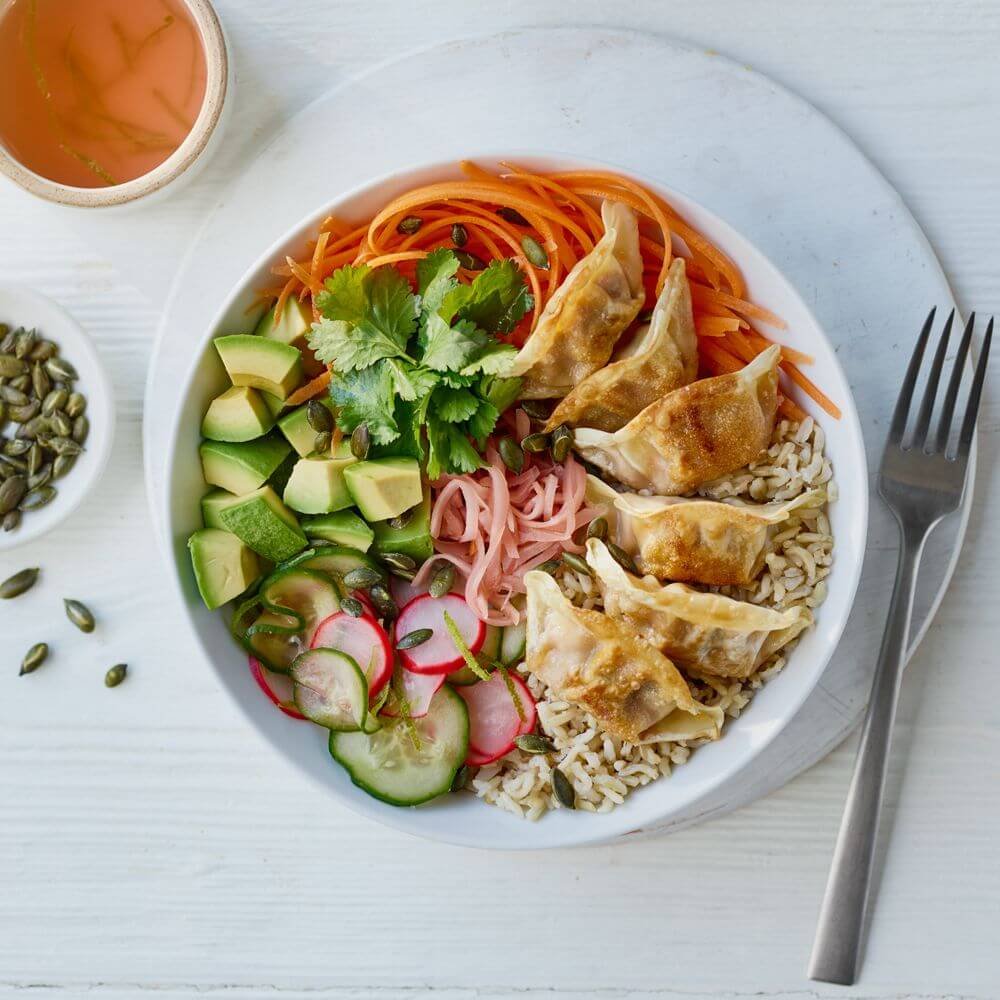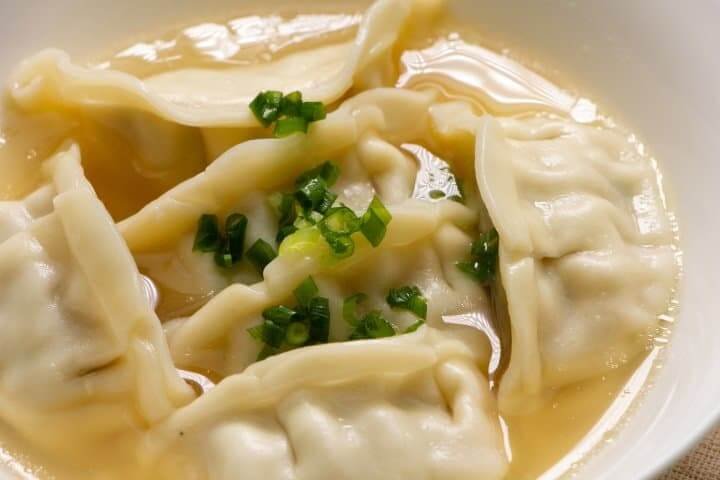
Gyoza are traditionally stuffed with a mixture of finely minced pork, mushrooms, and cabbage in Japan, creating a delectable blend of flavours and textures. Chinese dumplings, also known as Jiaozi or Potstickers, are popular in China and other regions of East Asia. Gyoza are wonderful meat and vegetable dumpling-like packages that are fried until crispy and then simmered in a fragrant broth to finish cooking.
What to eat with gyoza? More delicious food! Pairing well with many other Asian dishes, you can make a delicious side dish or rice noodles to accompany your dumplings. A rice dish, sour soup, or even just garnishing with sesame seeds, spring onions and green beans can elevate your chosen recipe.
Pairing well with so much Asian cuisine is both a blessing and a curse for this well balanced meal. You can’t really go wrong, but how will you ever know where to begin? Green onion, chinese broccoli, oyster sauce, what is the ideal side dish?
Choosing the dumpling side dishes is perhaps the toughest choice you’ll hve to make here, but thankfully the perfect side dish can be made to your own taste buds. Sweet or sour, hot or cool, any simple side dish can be selected by you to enjoy or share with friends.
Make Your Own Gyoza
You may think meat dumplings are relatively easy to make, and you wouldn’t be entirely wrong. However, without a favorite recipe and key ingredients, you may find your cooking methods unable to produce delicious results.
The Asian cooking style is without match, but thankfully with just a few common ingredients you can make a meal that will make your next family dinner a little more exciting. If you’re less interested in making your own dumplings by hand, then look out for Itsu vegetable fusion gyoza in your local store.
Making them by hand however should be on your list of fun ideas for your next family dinner. Depending on your cooking habit, you may consider the following recipe qucik as it takes less than sixty minutes. That’s included preparing the dumpling skins as well!
For the dumpling skin, our recipe recommendations say you will need:
- 2 tablespoons of cornflour
- 26 pre-prepared gyoza skins (defrosted if bought frozen)
- 3 tablespoons of vegetable oil
For the actual filling, try the following foolproof pork dumpling recipe:
- 4 spring onions, ends trimmed, roughly chopped
- 2 large leaves of Savoy or pointed cabbages, hard stem removed and roughly chopped
- 1.5 cm piece of ginger, peeled and chopped (or a ginger sauce)
- A single clove garlic (flavorful garlic improves most dishes)
- 50g water chestnuts, roughly 5
- 2 teaspoons of soy sauce
- 2 teaspoons of oyster sauce
- 1 teaspoon of sake
- Half a teaspoon of sesame oil
- 150g minced pork or chicken (try ready made ginger beef for variety)
A soy dipping sauce recipe, which we suggest, only needs three ingredients:
- 2 tablespoons of sweet soy sauce
- 1 tablespoon of rice vinegar
- 2 teaspoons of sesame oil
to complete this pan-Asian meal, why not add a Yuzu dipping sauce as well:
- 2 teaspoons of salted soy sauce
- 2 tablespoons of Yuzu juice
- 2 teaspoons of peanut oil

Cooking Your Gyoza
You may wish to use pan-fried sesame garlic tofu to replace the meat in your gyoza. This pan-fried sesame garlic tofu is a delicious substitute for a more vegetarian and vegan friendly alternative dumpling, if you wanted to edit this perfectly foolproof meal.
While you can decide what will make a good side dish to dumplings later, below is our recipe for cooking gyoza:
- 1) In a food processor, combine the spring onions, cabbage, ginger, and garlic to make a fine mixture (or finely chop by hand).
- 2) Pulse the water chestnuts to chop them up, but not too finely — they’ll give a wonderful crunch to the dish. Whizz again with the soy sauce, oyster sauce, sake, sesame oil, and a bit of salt.
- 3) Tip the ingredients into a bowl and add the minced pork or chicken. Mix by hand until well combined. Chill until ready to use.
- 4) Make sure you have a pot of water on hand. On a dish, sprinkle the cornflour. To construct the gyoza, place a heaping spoonful of the filling in the centre of the dumpling skin in the palm of one hand.
- 5) Dab your finger in water and blot over the skin’s edge to wet it and help the edges cling together.
- 6) Draw the skin’s borders together. Crimp folds on one side and press each pleat on the flat surface of the skin on the opposing side. Make sure you’re closing the packet and keeping the filling in the centre with each squeeze. Place each gyoza on a cornflour-dusted dish. Cling film can be used to keep the dish refrigerated for up to eight hours.
- 7) Cook the gyoza one at a time. 1 tablespoon vegetable oil, heated in a nonstick frying pan. Remove any extra cornflour from the dumplings’ bottoms using a brush. Only fry one side of the gyoza – don’t flip them; you only want one crispy side. After about two minutes, they should be golden brown.
- 8) Cover the pan with a steamed lid or a wide piece of foil with a few holes punched in the top and a splash of water. Cook for 3-5 minutes over medium heat, or until the water has evaporated and the gyoza filling is well cooked. Set aside while you finish the remainder of the meal.
- 9) In dipping bowls, combine all of the dipping sauce ingredients and serve alongside the dumplings. You can serve with both dipping sauces or just one.
- 10) Serve the gyoza dumplings alongside any one of a number of our side dishes, all of which are sure to taste and pair great!
Yakimeshi Fried Rice
Many Asian meals use fried rice, whether it’s a dumpling dense meal or excellent comfort meals from your local takeaway restaurant. Both Japanese and Chinese recipes may call for rice to be fried, but Japanese Yakimeshi is entirely different.

Miso Soup
Rich and sauce based dishes can be quite filling, and detract from the actual main course. Most Asian soups will do little to alleviate this, including authentic Wonton soup. However, as dumpling side dishes go, Japanese Miso soup is nice and light compared to Chnese soups.
Japanese Curry
This Japanese side dish is usually reserved for breaded Katsu chicken and white rice. However, the famously distinct flavour of Japanese curry compared to the curry of China and India sets it apart as an Asian side dish, perfect for Gyoza.
Spring Rolls
If green beans and oyster sauce aren’t for you, then this traditional side could be the perfect side dish for you. Spring rolls are, in actuality, an assortment of dishes both for meat consumption and vegetarians. Crispy onion, green onion, fresh ginger, bean sprouts, fresh garlic, and matchsticks of carrots can all make a fine vegetable roll.
If you prefer seasoned meat, then a juicy ground meat filling can be achieved using minimal ingredients. Why not add some black beans, and pair with a ginger sesame soy dressing or flavorful chili garlic sauce for an added kick of flavour.

East Asian Stir Fry
Fry vegetables and fresh veggies go well with anything, and if cooked in a healthy oil like sesame or olive, can be great for your body. Vegetable fusion gyoza is a popular vegetarian option, so why not toss some of your favorite vegetables into a stir fry as well!
Rainbow vegetable stir fry is a takeout classic with lots of veggies, using sauteed veggies of all colours to create a dish that literally looks as good as it tastes. Green vegetables also give you that healthy edge to have your body happy by the last bite.
Nutritious veggies come in all kinds of shapes, colors, and tastes allowing you to tinker where needed. Green veggies not your thing? Find some other colorful veggies to replace them with, there’s a whole range of veggies available so finding the right mix of veggies for you is relatively easy stuff.
When enjoying sauteed vegetables, you’ll find these now crisp veggies to be just as enjoyable as fresh veggies. But the best part is? Sauteed veggies are just as healthy for you! Perfect for a plant based diet, which is proven to be a great way to get plenty of nutrients into your body.
Roasted Char Sui Eggplant
A less common side dish in the West, roasted eggplant perhaps doesn’t sound very appealing. Yet, this simple side dish for dumplings is perfect for the plant based diets that have become increasingly popular in our modern world, while keeping a great taste.
This common veggie dish from Asia is also a solid vegan option, as opposed to the egg dishes common to join savory Potstickers on the side plates These can include corn egg drop soup, one of many Chinese soups. Provided you aren’t already using pork Potstickers of course, and instead using a strictly vegan Potsticker filling.

Ramen Noodles
Although Japanese, other noodles are common Chinese side dishes. Noodle dishes are served drained, often with osyer sauce, sesame oil, and some rice wine vinegar to add flavour. Pairing gyoza with these is an ideal meal union.
Noodles also present themselves in soups, in a very different way from the miso soup we discussed earlier. Both Asian chicken noodle soup and traditional Japanese noodle soup, are an ideal side dish for this Oriental flavoured adventure.
A bowl of ramen is typically enjoyed as a lunch snack by students everywhere, taking just a couple of minutes to make a microwave meal. However, crunchy ramen and wet ramen make a fabulous option for Japanese gyoza. For Chinese styled dumplings, consider Chinese egg noodles instead.


